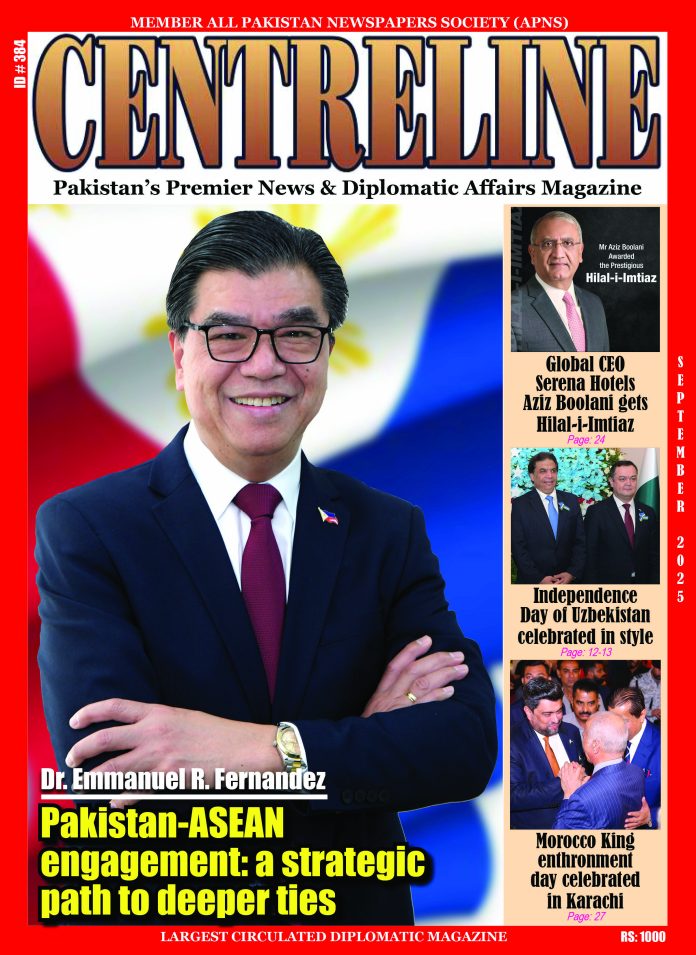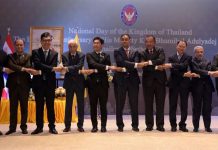In an exclusive interview with the Daily Islamabad Post, CENTRELINE magazine, and the Diplomatic News Agency, H.E. Dr. Emmanuel R. Fernandez, the Ambassador of the Philippines to Pakistan, outlined a comprehensive, multi-dimensional strategy to deepen engagement between Pakistan and the Association of Southeast Asian Nations (ASEAN). The Ambassador highlighted the significant, yet untapped, potential for collaboration across various sectors, from trade and economics to education and cultural exchange.
Ansar Mahmood Bhatti
Q: Your recent article in Daily Islamabad Post shed light on the growing ASEAN-Pakistan partnership. What inspired you to write this piece at this time?
The article was inspired by the confluence of two meaningful moments: the 58th founding anniversary of ASEAN and the growing momentum in ASEAN–Pakistan relations. As a Philippine diplomat posted in Islamabad, I have witnessed firsthand how engagement between ASEAN and Pakistan is shifting from aspirational dialogue to practical cooperation—across trade, education, cultural exchange, and more.
ASEAN Day provided an ideal opportunity to reflect on this progress and to highlight the Philippines’ commitment—both as a founding ASEAN member and as an active partner on the ground in Pakistan. I wanted to draw attention to the shared values and real potential that underpin this relationship, especially at a time when regional cooperation is becoming increasingly vital in addressing global challenges.
The article also aimed to capture the spirit of partnership that guides our diplomatic work—whether through trade missions, academic exchanges, or youth programs—and to encourage sustained, forward-looking collaboration in the Indo-Pacific region.

Q: You highlighted the importance of ASEAN centrality in regional cooperation. How do you see Pakistan’s role evolving within ASEAN frameworks like the ASEAN Regional Forum (ARF)?
Pakistan has been an active and constructive member of the ASEAN Regional Forum (ARF) since joining it in 2004. Over the years, it has consistently supported regional peace, security, and dialogue. A recent example was the 32nd ARF Ministerial Meeting in Kuala Lumpur in July 2025, where Pakistan’s Deputy Prime Minister and Foreign Minister reiterated the country’s commitment to ASEAN’s goals, emphasizing preventive diplomacy, respect for international law, and addressing non-traditional security threats such as climate change, cyber risks, pandemics, and maritime challenges.
Beyond statements, Pakistan also took part in productive bilateral and multilateral engagements on the sidelines of the meeting, reinforcing its intent to move from dialogue to deeper, action-oriented cooperation.
Looking ahead, Pakistan’s sustained and substantive participation positions it well to remain a credible and engaged partner in ASEAN-led regional initiatives.

Q: What concrete steps do you believe Pakistan can take to strengthen its engagement with ASEAN member states?
There is a lot of potential to deepen Pakistan–ASEAN engagement, and it begins with a strategic, multi-dimensional approach:
- Develop Sector-Specific Cooperation Agreements: Pakistan could follow models like the Vietnam–India partnership, which started with MoUs in IT and energy and expanded into defense and joint projects. Through its Special Investment Facilitation Council (SIFC), Pakistan could pursue similar MoUs in areas like digital trade, renewable energy, halal food, and logistics, opening doors to ASEAN’s large consumer market.
- Build on Economic Complementarities: Pakistan is a leading exporter of textiles, cotton, and halal-certified products—sectors that align with ASEAN import demands. For example, there is a real scope to integrate Pakistani textiles into the Philippine garment export chain. Similarly, the halal trade space offers untapped potential: both countries have national halal frameworks, yet no formal halal agreement exists. A bilateral MoU could help align standards, facilitate mutual recognition, and open halal markets further through joint trade missions and data sharing.
- Strengthen Academic and Human Capital Exchanges: Pakistan can expand its educational diplomacy by offering more academic exchange programs, particularly in medicine, engineering, and IT, to ASEAN students. This would enhance long-term people-to-people ties and foster goodwill among future leaders.
- Institutionalize Dialogue and Engagement: Pakistan has been part of ARF since 2004. To go further, it could support ASEAN-focused centers in Islamabad and establish a Pakistan–ASEAN Business Forum, following the successful models seen in ASEAN+ dialogues with partners like Japan.
- Promote Private Sector Linkages: Newer business groups like the Global Business Alliance can play a key role in connecting SMEs with ASEAN markets. A dual-track approach that engages both established chambers and emerging alliances will ensure broad-based private sector participation.
In short, by combining formal agreements, economic strengths, educational outreach, and business-led engagement, Pakistan can meaningfully strengthen its ties with ASEAN.

Q: How would you assess the current state of bilateral relations between the Philippines and Pakistan?
Relations between the Philippines and Pakistan have always been friendly and grounded in shared values—dating back to 1949. We have collaborated across diplomatic, multilateral, and development platforms, but there is certainly more potential to unlock, particularly in the economic domain.
While trade remains modest and tilted in Pakistan’s favor, both sides are aware of the opportunities and are working toward broader cooperation.
A few points stand out:
- Diplomatic Foundations: Our relationship is underpinned by structured mechanisms like policy consultations, a Joint Economic Commission, and regular embassy-level dialogues. These platforms ensure consistent and reliable engagement.
- Recent Diplomatic Momentum: The exchange of ambassadors and active participation in each other’s diplomatic events in 2025 reflect a shared commitment to keeping the relationship dynamic.
- Growing Economic Interest: Sectors like textiles, agribusiness, pharmaceuticals, and IT hold real promise, but scaling trade will require more targeted initiatives such as logistics improvements, trade facilitation, and regulatory alignment.
Overall, we are on stable footing, and the focus now is on translating this goodwill into concrete economic and development partnerships.

Q: What are the key priority areas for enhancing cooperation between our two countries in the next few years?
There is a strong alignment between Pakistan’s development agenda and the Philippines’ 2023–2028 Development Plan. This creates several natural areas for cooperation:
- Infrastructure & Energy: Both countries are investing in sustainable infrastructure and renewable energy. There is room for collaboration in clean energy, smart grids, and infrastructure technology.
- Industry & Commerce: Pakistan’s port modernization and industrial zones align well with the Philippines’ focus on logistics and manufacturing. Shared interests in textiles, garments, and maritime services offer clear pathways for engagement.
- ICT & Innovation: With Pakistan advancing AI and semiconductor programs, and the Philippines focusing on digital transformation, joint projects in cybersecurity, fintech, and digital upskilling would benefit both sides.
- Agriculture & Food Security: Pakistan’s investments in seed certification and traceability systems complement the Philippines’ efforts to modernize agriculture. This could lead to cooperative ventures in food processing and agricultural technology.
- Climate Resilience: Both countries are vulnerable to climate change. Initiatives like Pakistan’s eco-tourism and resilience funds mirror Philippine goals in disaster preparedness and sustainable development—making joint learning and advocacy possible.
- Human Capital Development: Skills development, especially in AI, data science, and women’s economic empowerment, is a shared priority, offering space for collaborative training and capacity-building programs.
These are areas where both countries can grow together through shared knowledge, investment, and innovation.
Q: Are there any cultural, academic, or people-to-people exchange programs in the pipeline?
Yes, a number of initiatives are either ongoing or planned, creating steady opportunities for cultural and academic exchange.
- Cultural Programming: The Philippine Embassy in Islamabad continues to host cultural showcases, National Day celebrations, and other events that highlight Filipino heritage and foster engagement with local communities.
- ASEAN Corner & Academic Exchanges: The Institute of Strategic Studies Islamabad (ISSI) has launched an ASEAN Corner and regularly hosts roundtables involving the Philippines. These events promote regional academic dialogue and policy exchange.
- People-to-People Outreach: Embassy-led field visits, such as those to Swat, along with university and business group engagements, keep the lines open for student exchanges, business cooperation, and cultural partnerships.
- Academic Pathways: While there is no large-scale bilateral scholarship program at present, Pakistani students do study in the Philippines, and university-level agreements help facilitate mobility. ASEAN-driven exchanges and ad-hoc scholarships also support academic links.
While the current pipeline is modest, it is active—and with the right support, it can scale into formal agreements, study visits, and joint scholarship initiatives.
Q: How is the embassy working to boost tourism and connectivity between the Philippines and Pakistan?
Tourism is a powerful tool for bringing people closer together, and the Philippines offers a wide range of destinations that Pakistani travelers would find appealing—from beautiful beaches to cultural and eco-tourism experiences.
The Embassy continues to actively promote the Philippines through cultural showcases, tourism campaigns, and partnerships. We are also coordinating with authorities back home to explore ways to improve travel connectivity—whether by facilitating direct flights, easing visa processes, or developing travel packages tailored to the interests of Pakistani tourists.
Q: What are the major barriers to trade and investment between the Philippines (or ASEAN) and Pakistan—and how can they be addressed?
There are several challenges that currently limit trade and investment between our countries, but all of them can be addressed through targeted cooperation.
Some of the key issues include:
- Low Market Awareness: Many businesses on both sides are still unfamiliar with the opportunities available. More trade fairs, business forums, and sector-specific information platforms would help.
- Non-Tariff Barriers and SPS Rules: Compliance with sanitary and phytosanitary standards, especially in agriculture, remains complex. Streamlining procedures and aligning standards would lower entry barriers.
- Halal Certification Gaps: While both countries have robust halal frameworks, formal mutual recognition is still lacking. Registering Philippine halal certifiers under Pakistan’s system and concluding an MoU would go a long way in solving this.
- Logistics and Customs Constraints: Improving port infrastructure, customs automation, and direct shipping channels can significantly reduce costs and time for trade.
Efforts like mutual recognition of standards, fast-tracking single-window systems, and leveraging ASEAN’s connectivity frameworks (like MPAC) can help tackle these barriers effectively.
Q: What is your perspective on regional connectivity projects like CPEC in relation to ASEAN’s connectivity goals?
Connectivity is central to ASEAN’s integration strategy, and projects like the China-Pakistan Economic Corridor (CPEC) have the potential to support that vision—if aligned properly.
ASEAN’s own connectivity plans—through its Master Plan on ASEAN Connectivity (MPAC 2025) and the ASEAN Outlook on the Indo-Pacific—prioritize not just physical links, but also regulatory alignment and people-to-people connectivity.
CPEC, with its infrastructure and trade potential, can offer important regional benefits—especially in energy and logistics. Gwadar Port, for example, could serve as a transshipment hub linking South and Southeast Asia. However, realizing these synergies will depend on factors like transparency, sustainability, and the ability to navigate political and geographic complexities.
Ultimately, for CPEC to complement ASEAN’s goals, it must align with regional norms and promote open, inclusive cooperation. If done right, such corridors can enhance integration between South Asia, Central Asia, and Southeast Asia.

















